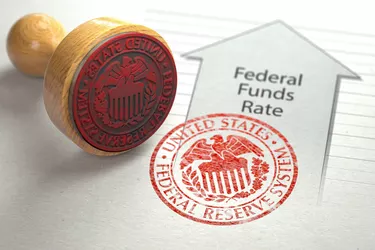
The Federal Reserve Bank, which is the central bank of the United States, has the responsibility to maintain a healthy economy in the United States. Its goals are to maximize employment and maintain a stable rate of inflation.
One monetary tool that the Fed uses to control economic activity is interest rates. Here's how the Fed uses interest rates to affect changes in the U.S. economy.
Video of the Day
Video of the Day
Consider also: How Do Interest Rates Affect the Customer Demand?
Federal Reserve Bank Controls Interest Rates
If the economy is sluggish and the unemployment rate is going up, the Fed must take monetary actions to stimulate economic activity and improve the labor market for jobs. On the other hand, if the economy becomes overheated and inflation is driving prices up, the Fed has the responsibility to enact monetary policies to cool the economy down and bring inflation under control.
The Federal Reserve Bank influences the market for interest rates by controlling the federal funds rate, which is the interest rate that banks charge each other for lending short-term funds overnight to meet reserve requirements. The Board of Governors of the Federal Reserve System uses its Federal Open Market Committee to make decisions about the level of interest rates. This committee meets eight times each year to set a target range for the federal funds rate.
Changes in the fed funds rate will affect the market for other interest rates, such as mortgages, personal loans, credit cards and the banks' prime rate. The prime rate is the interest rate that banks charge their most qualified customers with the lowest risk. Generally, the prime rate is three percentage points over the federal funds rate. Customers with more risk will pay higher percentage points above the fed funds rate.
Changing the Federal Funds Rate
Most of the time, the Fed will adjust the fed funds rate in one-quarter point increments. However, the Fed may raise or lower the fed funds rate by one-half point if they feel more aggressive rate hikes are needed.
For example, the recent coronavirus pandemic created havoc with the economy. Many businesses closed their doors, and people lost their jobs. This led the U.S. government to try and make up for these losses by issuing stimulus checks. This influx of money into the system led to an overheated economy, which created problems with the supply chain for all types of merchandise and commodities. This increase in demand led to a rapid increase in inflation.
As a result, Jerome Powell, Chairman of the Federal Reserve Bank, has announced that the Fed is considering multiple one-quarter point increases in the fed funds rate and maybe even an increase of one-half point.
Consider also: Relationship Between Interest Rate and Investment
The Federal Reserve Bank uses changes in interest rates to either stimulate a sluggish economy or to cool an overheated economy and slow down inflation.
Interest Rates Affect U.S. Economy
Raising interest rates will make it more expensive for consumers and companies to borrow money. Consequently, they reduce the demand and slow down economic activity.
Interest rate increases means it costs more for companies to borrow money to pay for expansion. Therefore, rising interest rates will slow down the rate of investment and expansion of a company's manufacturing facilities.
Conversely, a decrease in interest rates makes projects more economically viable and companies are more willing to borrow money and invest. This leads to more supply of goods, which brings down prices, and increases the availability of jobs, which reduces the unemployment rate.
Consider also: Interest Rate Effect on Aggregate Demand
Interest Rate Changes Impact Consumers
Interest rate changes affect both the rates on loans and the returns on savings accounts.
Financial institutions use the fed funds rate as a benchmark for pricing their products. This would include interest rates on home equity lines of credit, revolving credit cards and auto loans.
Interest rate changes can affect your major decisions, such as taking out a mortgage to buy a home, buying a car and even how you save to pay for a college education.
When consumers buy more houses, the demand for home furnishings and appliances goes up, putting more demand on the economy. Higher interest rates also affect the decisions of lenders, who might decrease their willingness to approve loans.
Financial institutions also use the fed funds rate to set the interest rates on savings accounts, bonds, money market accounts and certificates of deposit. Rising interest rates encourage people to save more money.
- Forbes: What Happens When The Fed Raises Interest Rates?
- U.S. News: How Federal Interest Rates Work
- Federal Reserve System: The Fed Explained
- Federal Reserve Bank of Cleveland: Why Does the Fed Care about Inflation?
- Vermont Federal Credit Union: How the Fed Interest Rate Impacts Your Finances
- U.S. Securities and Exchange Commission: Interest Rate Risk
- CNBC: Powell Says Taming Inflation ‘Absolutely Essential,’